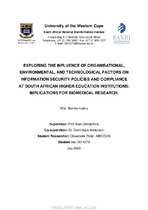| dc.description.abstract | Headline reports on data breaches worldwide have resulted in heightened concerns about information security vulnerability. In Africa, South Africa is ranked among the top ‘at-risk’ countries with information security vulnerabilities and is the most the most cybercrime-targeted country. Globally, such cyber vulnerability incidents greatly affect the education sector, due, in part, to the fact that it holds more Personal Identifiable Information (PII) than other sectors. PII refers to (but is not limited to) ID numbers, financial account numbers, and biomedical research data. In response to rising threats, South Africa has implemented a regulation called the Protection of Personal Information Act (POPIA), similar to the European Union General Data Protection Regulation (GDPR), which seeks to mitigate cybercrime and information security vulnerabilities. The extent to which African institutions, especially in South Africa, have embraced and responded to these two information security regulations remains vague, making it a crucial matter for biomedical researchers. This study aimed to assess whether the participating universities have proper and reliable information security practices, measures and management in place and whether they fall in line with both national (POPIA) and international (GDPR) regulations. In order to achieve this aim, the study undertook a qualitative exploratory analysis of information security management across three universities in South Africa. A Technology, Organizational, and Environmental (TOE) model was employed to investigate factors that may influence effective information security measures. A Purposeful sampling method was employed to interview participants from each university. From the technological standpoint, Bring Your Own Device (BYOD) policy, whereby on average, a student owns and connects between three to four internet-enabled devices to the network, has created difficulties for IT teams, particularly in the areas of authentication, explosive growth in bandwidth, and access control to security university servers. In order to develop robust solutions to mitigate these concerns, and which are not perceived by users as overly prohibitive, executive management should acknowledge that security and privacy issues are a universal problem and not solely an IT problem and equip the IT teams with the necessary tools and mechanisms to allow them to overcome commonplace challenges.
At an organisational level, information security awareness training of all users within the university setting was identified as a key factor in protecting the integrity, confidentiality, and availability of information in highly networked environments. Furthermore, the University’s information security mission must not simply be a link on a website, it should be constantly re-enforced by informing users during, and after, the awareness training. In terms of environmental factors, specifically the GDPR and POPIA legislations, one of the most practical and cost-effective ways universities can achieve data compliance requirements is to help staff (both teaching and non-teaching), students, and other employees understand the business value of all information. Users which are more aware of sensitivity of data, risks to the data, and their responsibilities when handling, storing, processing, and distributing data during their day to day activities will behave in a manner that would makes compliance easier at the institutional level. Results obtained in this study helped to elucidate the current status, issues, and challenges which universities are facing in the area of information security management and compliance, particularly in the South African context. Findings from this study point to organizational factors being the most critical when compared to the technological and environmental contexts examined. Furthermore, several proposed information security policies were developed with a view to assist biomedical practitioners within the institutional setting in protecting sensitive biomedical data. | en_US |

